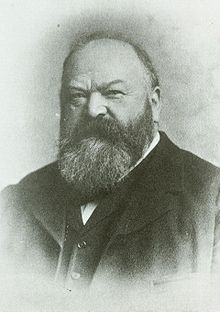Andrew Ainslie Common
| Andrew Ainslie Common | |
|---|---|

Andrew Ainslie Common
|
|
| Born | 7 August 1841 Newcastle Upon Tyne |
| Died | 2 June 1903 |
| Residence | Ealing, London |
| Citizenship | English |
| Fields | Astronomy |
| Known for | astrophotography |
Andrew Ainslie Common FRS (1841–1903) was an English amateur astronomer best known for his pioneering work in astrophotography.
Common was born in Newcastle Upon Tyne on 7 August 1841. His father, Thomas Common, a surgeon known for his treatment of cataract, died when Andrew was a child, forcing him to go early into the world of work. In the 1860s he teamed up with an uncle in the sanitary engineering firm of Matthew Hall and Company. He married in 1867. In 1890 he retired from Matthew Hall. Andrew Ainslie Common died of heart failure 2 June 1903.
Although Common's professional career was in the field of sanitary engineering, he is most noted for the work he did as an amateur in the field of astronomy. As a child Andrew showed interest in astronomy. At age 10 his mother borrowed a telescope for him to use from a local doctor, Dr. Bates of Morpeth. He returned to astronomy in his 30's when he took up experimenting with gelatin plate photography of the moon and planets with a 5.5 inch refracting telescope.
In 1876 Common became a Fellow of the Royal Astronomical Society. About this time he also moved to Ealing outside London where he would live for the rest of his life operating an astronomical observatory from the back garden of his house. Common realised he would need very large telescopes to gather enough light to record the images of stars photographically so he began building a series of ever larger Newtonian reflecting telescopes using the then new technology of silver coated glass mirrors. For the first of these, a telescope of his own design constructed in 1876, he tried to grind and polish his own 17 inch mirror but gave up on the idea and ordered an 18 inch (46 cm) mirror from the optical firm of George Calver of Chelmsford. In 1877 and 1878 he published several articles on his visual observations of the satellites of Mars and Saturn.
In 1879 he bought a new 36-inch (910 mm) mirror from Calver to mount in a larger Newtonian reflecting telescope he was building. He used it to make further observations of satellites of Mars and Saturn, and was able to see Saturn's moon Mimas and show that the ephemeris of its orbit was incorrect. With this instrument he also obtained a photograph of a comet in 1881, C/1881 K1. His most notable work with this telescope were the long time exposures he made of the Orion Nebula between 1880 and 1884. His 1883 photograph of that nebula for the first time showed photography's ability to record stars and other features invisible to the human eye. Common noted of his own photographs that:
...
Wikipedia
